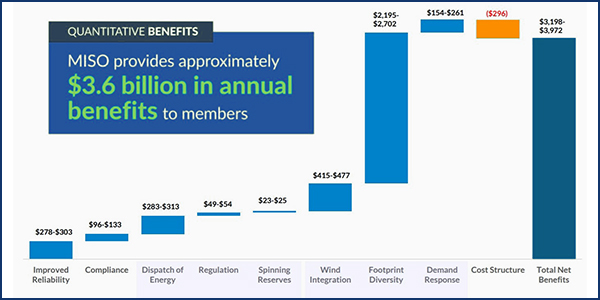By Amanda Durish Cook
MISO saved members between $3.2 billion and $4 billion over the course of 2019, the RTO said last week.
The savings could be attributed to “enhanced reliability, more efficient use of the region’s existing assets and a reduced need for new assets,” MISO said in its annual Value Proposition study, which compares benefits of RTO membership against going it alone on the grid.
The estimated value to members was partially offset by $296 million in MISO administrative costs.
The savings are nearly identical to 2018, when MISO estimated it delivered between $3.2 billion and $3.9 billion in benefits to members. (See MISO Claims up to $3.9B in 2018 Benefits.) The RTO said it has documented nearly $27 billion in member benefits since 2009.
MISO executives discussed the most recent customer savings estimates during a special conference call Friday.
“Value Proposition on Valentine’s Day. Nothing could be more appropriate,” Executive Director of Market Operations Shawn McFarlane had joked at the Market Subcommittee meeting Feb. 6.
MISO said the lion’s share of last year’s value — $3.1 billion — could be chalked up to a diminished need for more grid assets. Those savings were further broken down to $415 million to $477 million from MISO’s wind generation integration, $154 million to $261 million from its demand response program and $2.2 billion to $2.7 billion from its vast geographic footprint.
Improved reliability accounted for a $405 million in savings, while a more efficient use of the footprint’s existing assets accounted for another $374 million, consisting of savings from more efficient dispatch ($283 million to $313 million), regulation reserves ($49 million to $54 million) and spinning reserves ($23 million to $25 million).
“The benefit of our large footprint is peaks occur at different times,” said Leonard Ashley, MISO senior business adviser of strategy and business development, adding that hot weather doesn’t often occur simultaneously in Indiana and the Dakotas, allowing the RTO to more easily distribute supply.





